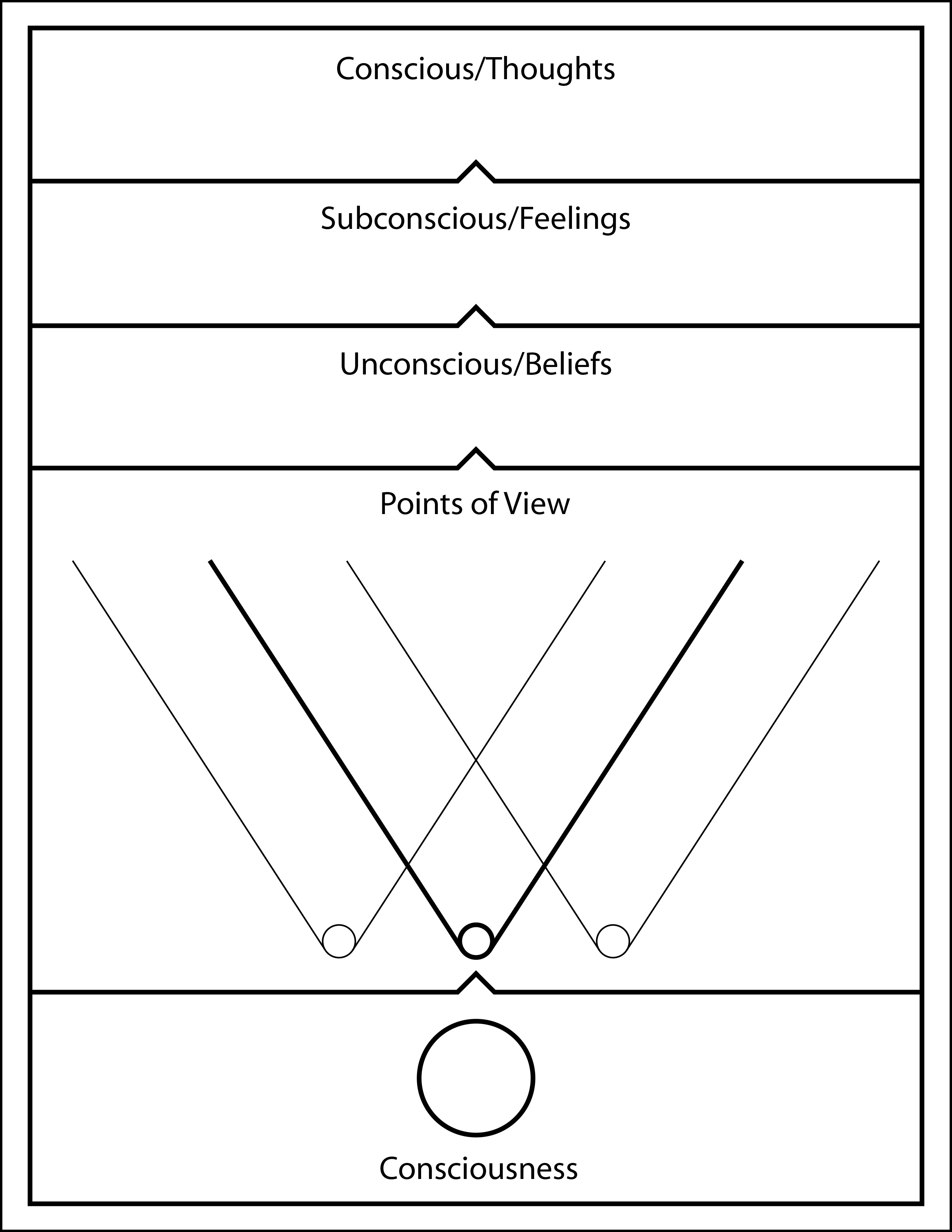Lesson 11 – What is the Person?
I was desirous of freedom enough to not take pride in my self-created suffering and personal drama; when I saw I could dis-identify from it, I did. I recommend you do the same: Give up your right to believe you are “a person” and see that there is no further value in continuing to identify yourself with a drama-driven life. It’s one of the absolute best gifts you can give to yourself. Bentinho Massaro
This lesson offers a simple step-by-step description of what comprises “the person” and explains the three means of conditioning we are exposed to that form our personality and determine our perspective on life.
From that angle, this lesson also touches upon the idea of shifting from feeling separate to feeling inseparable, from feeling contracted to feeling connection.
You may find this lesson a little bit “dry and intellectual,” as it simply offers an overview of how the person-idea developed and what it roughly consists of. But the lessons following this one will take you deep into transcendence.
Enjoy yourself as a person while you can.
What is “The Person”?
“The person” started as an idea the moment you became aware of the fact that you (apparently) had a body, and that people called that body by a certain name. They called it you.
Everything you approached in this world was experienced from the same focal point of the body, over and over again. No matter what you did or where you went, the body appearance remained your focal point from which, and through which, to gain experiences on this physical plane.
When you tried standing up, you had to somehow make your body do some balancing work. When you stubbed your toe on something, your body felt pain. When your mother smiled at you, her eyes would point in the direction of your eyes. When people called your name, they expected you to look in their direction, and when you did, they showed signs of acknowledgement.
This constant association of your Beingness-Consciousness (I-AM) with the body-appearance gave rise to the idea and consequent feeling, “I am the body,” or “I-AM-This.”
As this idea and feeling progressed, and the association was further strengthened over the years, what was initially just an idea, turned into a deeply rooted and automatic belief that formed the energetic foundation of your personality: the conviction “I am this body” was the fertile ground for your psychological sense of self (mind) to develop within.
With the body as the basis of what you were, you could now start to develop who you were, as a personality with stories and possessions, skills and challenges, desires and preferences—unique from everybody else in certain ways.
For the body-mind appearance to stand out to Consciousness as “this is what I am,” there must be contrast—there must be something Consciousness thinks it is not. Without that contrast, Consciousness would simply identify with all that appears, in equal measure.
The necessary contrast was provided by the appearance of “the world,” which, in our society, is largely agreed to be external to us—as “out there,” or “not us.”
Thus, the rather distorted feeling of separation was born: not only were you the body, but everything else was also separate from you.
Three Primary Forms of Conditioning
- Social conditioning
- Environmental friction, or physical-perception-based conditioning
- Self-reflection, contemplation, and meditation
1. Social conditioning
The first form of conditioning is usually offered by our parents initially, and is then reinforced by our family, our circle of friends, our schools and teachers, strangers, the media, the Internet, government, society, and so on.
Social conditioning includes verbal, conceptual, and energetic conditioning. Our parents give us a name, tell us what is right and wrong, share their beliefs with us, punish and reward us. They display emotions in response to events, and they interact with other adults in distinctive ways.
All of this imprints upon us energetically, conceptually, and verbally, and this is where the great majority of negative, limiting, and distorted beliefs we carry around with us today originate.
Somewhere along the way, in the process of “growing up,” we acquired an enormous number of beliefs that were not originally ours. These beliefs didn’t come to us through inspired contemplation or intuitive clarity regarding how the universe works. No, these beliefs were manmade; our parents picked them up somewhere along their path (also unoriginal to them) and simply transferred their updated versions onto us. We then “chose” to make these beliefs our own, and so shape our realities.
If the beliefs we adopted are in alignment with our purpose, our passion, and our Higher Self’s true vibration, they feel overwhelmingly good, reassuring, positive, and supporting to us. They then help us build the structure of energy that we could call “our world,” or our circumstances.
If the beliefs we adopted are not in direct alignment with what our Higher Self sees and desires for this life, then these beliefs turn into feelings of a negative nature, causing the wide range of human emotions that we have labeled with different names.
Despite all these names, ultimately we have only two emotions: Joy/Excitement and Depression/Anxiety. These are really just two ends of the same emotional spectrum, so we could also say that we only have access to one emotional spectrum or field.
When we feel joy or excitement, it signifies that our belief system is in alignment with our true frequency of being, whereas when we feel depression, anxiety, or negativity of any kind, this is pointing us to the fact that what we believe is simply not true for us and does not serve the manifestation of our truly desired, heart-felt dream life.
Much more on this alignment principle will be addressed in depth in the Empowerment teachings.
This form of conditioning, the social type, is what most people who are interested in personal or spiritual growth are dealing with today, through observation, analysis, and in some cases, transcendence—realizing it’s not who they are at all.
In my Enlightenment and Infinity teachings, we aim to transcend our assumed identities altogether, so we can see the deeper levels of our eternal existence. In my Empowerment teachings, on the other hand, we will realign all of the individual energies so that the mind/body/spirit being becomes laser-like in its intended purpose, in its meant-to-be passionate and limitless expression of Infinity.
2. Environmental friction, or physical-perception-based conditioning
Most people on the spiritual or self-help path seem to be aware of the fact that their conditioning comes from the social sources mentioned above. However, the second form of conditioning is in some ways more fundamental and tends to program itself quite deeply into our automatic mind, forming the basis of our nervous system’s conditioned responses to life.
That being said, it’s usually much easier to dis-identify from this type of conditioning.
If social conditioning forms the contents of our mind, environmental conditioning forms the rudimentary, animalistic container for these contents. It’s similar to the difference between our personality self-identity defining the content of who we are, and our body self-identity forming the foundational context that we feel is what we are.
Environmental friction plays a prominent role in the development of the sense of oneself as a separate entity in a “hostile,” or external, world. It is the conditioning offered to us by our physical environment, by the friction that occurs when you put a moving physical vehicle inside of a physical world.
It’s the “stubbing your toe on a rock” kind of conditioning; it’s the feeling of gravity, the seeing of things “over there” in relation to our body, which seems to be always “over here.” It’s the “time” it takes to get from China to the United States, and all the intermediary steps of transportation that must be dealt with.
To a great extent, it’s physical conditioning, or environmental friction, that makes us feel like we’re victims of, or at least inhabitants of, a linear space/time container. There are many environmental factors that condition us, on a very basic level, to feel we are the body and that we are separate and isolated and temporary (subject to death).
Even if we had been born on a planet with no social influences whatsoever, and no other human beings, we would still most likely develop a strong sense of “being the body” and “being separate from our environment.” We would still most likely feel that we were living inside a space/time container—due to simple, basic actions like running around on the surface of the planet, bumping into things as we go along, receiving constant physical feedback from our experience, seeing the sun rise and set every day, and searching for food to satisfy our body’s hunger sensation.
Environmental conditioning can be thought of as the instinctual, or animalistic, part of our body-selves. It’s what initiates the physical survival response that often flares up before we even have time to think about things from the socially conditioned part of our mind—especially in seemingly physically threatening situations. It’s what activates the adrenaline in your body, and puts you on high alert. It’s what freezes your body as you approach the edge of a cliff. It’s what gives you “a scare” when a funny (or not so funny) neighbor hides in your closet at night and pops out to see your response.
It’s a physicality-oriented, nervous system type of conditioning, and although deep, it belongs only to the bodily vehicle, and not to you.
Most people do not feel heavily identified with this response, even if the sensations that come with this conditioning are quite strong. They don’t feel that it is “who they are,” and they can quite easily understand that it is not who they are.
As such, this type of conditioning is not often seen as a “problem” to overcome psychologically. Nevertheless, it does contribute significantly to many of our everyday feelings of contraction and our self-protection responses to events.
Even after you’ve freed yourself from many (or most) of your personal and/or socially-induced fears, the physical conditioning may still have its way with your body, because that is its purpose—to respond when it needs to respond. This is most noticeable to us in times of immediate physical threat.
However, even these very animalistic effects can be greatly softened and untangled, the more we recondition our nervous system, by showing it our experience of the soothing presence of non-separate is-ness or beingness, and seeing over and over again that everything is our Self, and therefore safe—even threatening circumstances.
Which brings me to our third type of conditioning:
3. Self-reflection, contemplation, and meditation
The third major means to condition oneself is more advanced, kicks in later in the development of our bodily-complex, or age, and although most humans make use of this to some extent from a certain age onwards, when this happens seems to be governed and influenced largely by the first two types of conditioning.
The ability to self-reflect, or contemplate, tends to run around in a loop or pattern for most people, which leads us to question whether it is truly self-reflection or merely the echoes of what the entity has heard before through the verbal/conceptual/social means of conditioning.
It isn’t until this third means of conditioning (and de-conditioning) reaches a significant point in its lucidity and its mind-transcending capabilities, that it becomes a source of increased clarity, rather than more of the same limiting conditioning.
This third way starts to stand on its own and offer solutions to the contractions of the conditioned human body-mind, once it is able to look at itself as-if from outside the box that was created by the first two methods of conditioning.
When it begins to stand on its own, it usually does so either by way of the psychological approach of careful self-analysis, or by way of the spiritual approach, through contemplation of the spirit portion of one’s mind/body/spirit beingness. The latter approach has the benefit of activating more of one’s innate ability to access the intuitive mind, as well.
Whether psychologically-inclined, or spiritually-activated, the ability to self-reflect also conditions us to see life from different angles. In a sense, everything does.
Nevertheless, this third method of (re)conditioning oneself is a most helpful gateway into spiritual realization and the transcendence of past conditioning.
I consider you, the seeker of spiritual realization, to have already opened this gateway. You have become, in this sense, intelligent and responsible for your sense of self.
The 5 Levels of Consciousness (Relevant to the Human Being)
- Tune into I-AM for a moment… Just that naked, pure sense of I-AM, with nothing attached to it as a distraction. Pure Presence….
- Now, imagine that this I-AM Presence can, through intelligently altering its vibration, generate endless different points of view. In other words, Presence-Consciousness can, through vibration, change what it sees and how it sees what it sees. It can interpret appearances from all kinds of different understandings.
- When consciousness then lands on a certain point of view and deems it true or relevant, it “chooses” to crystallize that point of view into a more solid form, so that this solid form can function as the stage for a play to appear on. This crystallized state of an otherwise malleable and etheric point of view, is a “belief.”
Beliefs can also be understood as the unconscious mind of a person. - Imagine that a person carries a certain belief that has formed its context, its background—the unconscious underlying conviction from which it perceives the events in its life. Now, imagine this person encountering a situation that triggers this belief. When triggered, the belief will generate a feeling or emotion in the person.
Emotions, or feelings, can also be understood as the subconscious mind of a person.Side note: The feeling that has been triggered may be positive or negative, depending on whether the belief was in or out of alignment with this being’s Higher Self. Beliefs are the energies that create the person’s inner and outer reality. Hence, it is of true value to get to know oneself on this level more clearly. More on this will be offered in the Empowerment teaching. - Finally, the conscious mind, the thinking mind, reacts to the feelings in the body. Thoughts are really nothing more than reactions to what has already occurred, to what is already aroused by means of beliefs and feelings in the person. They are the end of the line, and therefore, they are not the level that actually creates our reality.
Diagram of the 5 Levels of Consciousness
Here is how all these levels of consciousness relevant to the human experience, structurally, connect together. Starting from most fundamental to most surface-level, from creator to created, from cause to effect:
- I-AM (Presence-Consciousness)
- Points of view (vibration/state of being/understanding)
- Beliefs (unconscious mind—a crystallized point of view)
- Feelings (subconscious mind—triggered depending on belief)
- Thoughts (conscious mind—reactive)
The last three together (Beliefs, Feelings, Thoughts) form the person; the crystallized, manifest portion of an individual’s expression of Presence.
When a thought or circumstance triggers an underlying belief, it generates a feeling. That feeling then causes further reactions or reflections by the conscious mind, or—(more) thoughts.
I will not go too deeply into this now, but I wanted to offer this overview to you and lay out the structure: the fact that beliefs cause feelings, and feelings cause thoughts. Noticing this in your everyday life can help you see more clearly how “the person” operates in you, so you can realize your freedom from it that much more vividly.
The more clearly you see how the person engages in these automatic shenanigans, the easier it is either to change these habitual patterns, and/or to see that, ultimately, it is not what you are.
The Illusion of Separation Leads to Contraction
Once we identified with the body and could feel its pains, we were automatically wired, from that point onwards, to protect ourselves against whatever was “not us”—in this case, everything besides our own body, including other selves.
This brings us to examine a very basic, but crucial, topic: the different levels on the spiritual spectrum, which range from the very animalistic state of separation and self-protection, on the one hand, to some of the highest states of spiritual understanding, on the other hand:
-
Condition of Separation
If everything, except for the body, is seen as not you, then everything forms a threat to your existence (as the body). This applies to the Person-World-Consciousness level (I-AM-This). -
Condition of Wisdom
When nothing is seen as you, then nothing poses a threat to your existence, because you are not identified with the body. This applies mostly to Awareness and Infinity levels (I-I and No-I). -
Condition of Love
When everything is seen as you, you also don’t feel a threat because you know that everything is your Self. This applies mostly to Awareness and Presence-Consciousness levels (I-I and I-AM).
These very simple distinctions can be likened to physics:
- If you perceive only the body as yourself, you will contract.
- If you perceive everything as not yourself, you will disappear.
- If you perceive everything as yourself, you will expand.
As soon as we developed a personality, or mind, and added it to our “I-AM-This” sense of self, we started protecting ourselves mentally and emotionally—in addition to physically. Again, this was due to our partial identification with creation: seeing only the body-mind as who we are, not everything else, as well.
We started hiding from other parts of our being (other-selves), as we perceived them to be separate from us, and thus considered them a potential threat to our mental-emotional privacy-existence, or simply as a potential source of suffering.
From Person to Presence; From Separation to Inseparability
The sense of separation that dominates most people’s actions in life can be relieved, uprooted, and dismantled. It is a major reason why waking up from Person to Presence is such a worthwhile realization to invest your dedication and practice into.
Realizing Presence-Consciousness to be what you are—which the next few lessons will aid you with profoundly—will greatly alleviate the conviction of separation, since it shows you experientially that you are not just the body-mind creation—you are the Presence that makes up all of Creation.
Presence-Consciousness will show you that everything you can ever encounter is simply more of your Beingness, and therefore safe and friendly.
The beauty of life as a human is that every moment offers another opportunity to label the things you encounter as either separate from yourself, or as more of your Self.
Hence, from this day forward, let’s regard anything that is not your body-mind appearance not as external to me, outside of self, or even as the world, but as simply being the rest of myself, or more of myself.
And for sake of clarity, when we’re talking about other beings, let’s use the term other-self, which includes the word “self,” implying that others are simply other portions or aspects of (our) self, or Self (Presence-Consciousness Self).
Terminology Summary
The Person refers to the body-mind appearance.
Person-Consciousness usually refers to Awareness identified with the body-mind appearance.
Person-World-Consciousness refers to the totality of the individual identity-experience, complete with its perceived external, separate-from-itself associations, possessions, relationships, actions in life, and so on.
Homework
- Read this lesson’s text at least once more before proceeding. This lesson’s contents are somewhat technical and dry, but when this overview of the make-up of the person-identification is applied to your every day life experiences, the contents become more alive in you as actual wisdom. In order to support that, it might prove helpful if you dissect and study this lesson and see how it applies to your own mind.
- Study the “5 Levels of Consciousness (Relevant to the Human Being)” diagram and see in your direct experience how the I-AM-Consciousness generates different perceptions by altering its point of view (vibration), how this point of view then—when chosen as real, or valid—crystallizes into a belief-system, and how this belief activates feelings when it is challenged or triggered by outside events or thoughts. Finally, see how the thinking mind then comes in and reacts to the feelings, attempting to protect itself or gain knowledge from what just occurred by contemplating (thinking about, reacting to) what’s going on.
- Sit down and contemplate five real-life examples of yours, whether recent or long ago, and see how an event triggered your feelings, and that this could only have happened because you had a belief about what occurred. See how—or where—that belief originated as a point of view that you—at the time—started seeing as real, true, or relevant.
Note: It is helpful if you get a clear experiential sense of how these 5 levels of Consciousness are present—and operate—in your every day life, because in the Empowerment teaching we will again utilize this diagram, but as a means to further enhance our ability to shift into parallel realities. So, it is a good idea to familiarize yourself with this diagram, in a very basic and observational way, now.
Consider sharing your experiences with this lesson and its homework in the corresponding Lesson 11 Study Group, and/or ask other members for their input and tips.























